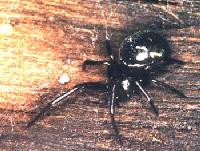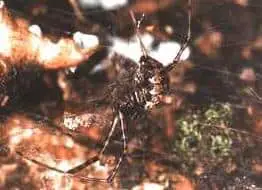Theridiidae is a large family of spiders, also known as the tangle-web spiders, cobweb spiders and comb-footed spiders. The diverse family includes over 2200 species in over 100 genera)of three-dimensional space-web-builders found throughout the world.
Theridiid spiders are entelegyne (have a genital plate in the female) araneomorph ecribellate (use sticky capture silk instead of woolly silk) spiders that often build tangle space webs and have a comb of serrated bristles (setae) on the tarsus of the fourth leg.

A Comb Footed Spider has a row of bristles like a tiny comb, on each hind leg. The comb is so small you could only see it with a strong magnifying glass and is used for spreading out the spider’s silk so that prey caught in the web can be quickly tied up into a “food parcel”. It is not used for web making so is different from the rake used by lace web making spiders.

Comb Footed spiders feed on flying insects. They are found in all countries and throughout Australia. Most of them make a triangle or cobweb of some kind which you could find almost anywhere. The egg sacs are usually round, made of either fluffy or papery silk and hung in the web or from a leaf. The young spiders may stay in the web with the parent for some time.
There are many kinds of Comb Footed spiders and they all belong to the same family. They are mainly small to medium sized spiders and most have a pea shaped body and small cephalothorax, but a few are oval or long. Common kinds of Comb Footed spiders found around houses are the Grey House spider and the Red Back spider.
The Quicksilver or Dewdrop spider has a silver body. It does not build a web but lives in the outskirts of the web of a larger spider such as a Tent spider. It feeds on tiny insects the large spider overlooks. The egg sacs are hung near the large web.
The bite of the common comb footed spider causes mild local pain unlike the redback/widow spiders whose bites should be treated immediately with antivenom, especially in a young child.
Information by Lachlan
Pictures used with permission from Ed Nieuwenhuys
Information and pictures were taken from children’s projects and where credited to that child does not claim to be original information. Where possible, permission to reproduce has been sought. Any infringement of copyright is purely unintentional.
